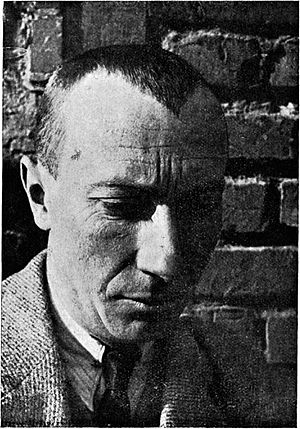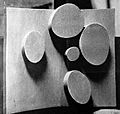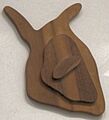Jean Arp facts for kids
Quick facts for kids
Jean Arp
|
|
|---|---|

A photo of Jean Arp from 1926
|
|
| Born |
Hans Peter Wilhelm Arp
16 September 1886 |
| Died | 7 June 1966 (aged 79) |
| Nationality | German |
| Education | Académie Julian |
| Known for | Sculpture, painting |
| Movement | Abstraction-Création, Surrealism, Dada |
| Spouse(s) | Sophie Taeuber-Arp, Marguerite Arp-Hagenbach |
Hans Peter Wilhelm Arp (born September 16, 1886 – died June 7, 1966), better known as Jean Arp, was an artist from Germany and France. He was a sculptor, painter, and poet. He was famous for being a Dada artist and an abstract artist. This means his art often used shapes and colors instead of showing things as they look in real life.
Contents
Early Life of Jean Arp
Arp was born in Straßburg, which is now called Strasbourg. His mother was French, and his father was German. At the time he was born, this area, called Alsace-Lorraine, belonged to Germany. This was after a war between France and Germany in 1871.
After World War I ended, Alsace became part of France again. Because of French law, his name changed to "Jean." But when he spoke German, he still called himself "Hans."
Jean Arp's Artistic Journey
In 1904, Arp left art school in Straßburg and went to Paris. There, he published his poems for the first time. From 1905 to 1907, he studied art in Weimar, Germany. In 1908, he returned to Paris to study at the Académie Julian. Arp helped start a group called Moderne Bund in Lucerne, and he showed his art in their exhibitions from 1911 to 1913.
In 1912, he visited Wassily Kandinsky, a very important Russian painter, in Munich. Kandinsky encouraged Arp's art. Arp then showed his work with Kandinsky's group, Der Blaue Reiter. Later that year, he had a big exhibition in Zürich with other famous artists like Henri Matisse and Robert Delaunay. In 1913, a powerful art dealer named Herwarth Walden helped Arp show his art in Berlin.
In 1915, Arp moved to Switzerland because it was a neutral country during the war. He wanted to avoid joining the German Army. He later told a funny story about how he pretended to be mentally ill. He kept writing the same date over and over on official papers, and the German officials believed he was unwell, so they didn't make him join the army.
That same year, he met Sophie Taeuber, who was a dancer and artist. They got married a few years later.
In 1916, a place called Cabaret Voltaire opened in Zurich. It became the main spot for the Dada art movement. Arp was part of this group, along with other artists like Marcel Janco and Tristan Tzara. In 1920, Arp helped start the Dada group in Cologne, Germany. In 1925, his art was shown in the first exhibition of the Surrealist group in Paris.
In 1926, Arp moved to a town near Paris called Meudon. In 1931, he left the Surrealist group and helped start a new group called Abstraction-Création. This group focused on abstract art. From the 1930s onwards, Arp started making sculptures out of bronze and stone, not just collages and flat art. He even made small sculptures with parts that viewers could move around and rearrange.
He also wrote and published essays and poems throughout his life. In 1942, he had to leave his home in Meudon to escape the German occupation during World War II. He lived in Zürich until the war ended.
In 1949, Arp visited New York City for an art show. In 1950, he was asked to create a relief sculpture for Harvard University in Massachusetts. He also got a job to make a mural for the UNESCO building in Paris. Art dealers Arthur and Madeleine Lewja helped make Arp famous in America.
Major Exhibitions
In 1958, a big show of Arp's art was held at the Museum of Modern Art in New York City. Another major exhibition followed in Paris in 1962. In 1972, the Metropolitan Museum of Art showed many of Jean Arp's works. This exhibition later traveled to seven museums in the United States and six in Australia. In 1986, a large exhibition called "The Universe of Jean Arp" toured several cities and ended at the San Francisco Museum of Modern Art.
The Musée d'art moderne et contemporain of Strasbourg has many of his paintings and sculptures.
Awards and Recognition
Jean Arp received many important awards for his art. These include:
- The Grand Prize for sculpture at the 1954 Venice Biennale
- Sculpture prizes in Pittsburgh in 1964
- The Grand Prix National des Arts in 1963
- The Carnegie Prize in 1964
- The Goethe Prize from the University of Hamburg in 1965
- The Order of Merit with a Star from the German Republic
Personal Life and Passing
Arp and his first wife, the artist Sophie Taeuber-Arp, became French citizens in 1926. In the 1930s, they bought land in Clamart and built a house near a forest. Sophie designed the house, inspired by modern art and design styles. Sadly, she died in Zürich in 1943 from accidental carbon monoxide poisoning. After living in Zürich for a while, Arp moved back to Meudon in 1946.
In 1959, Arp married Marguerite Hagenbach (1902–1994), who had been his companion for a long time. He passed away in 1966 in Basel, Switzerland.
Quotes by Jean Arp
Jean Arp had many interesting ideas about art:
- "I hereby declare that on February 8th, 1916, Tristan Tzara discovered the word Dada. I was present with my twelve children, and I wore a brioche in my left nostril. I am convinced that this word has no importance and that only imbeciles and Spanish professors can be interested in dates. What interests us is the Dada spirit and we were all Dada before the existence of Dada." (from Arp's 'Declaration', October 1921)
- "Art is fruit growing out of man like the fruit out of a plant like the child out of the mother... Through reason man became a tragic and ugly figure." (around 1932)
- "These paintings, these sculptures – these objects – should remain anonymous, in the great workshop of nature, like the clouds, the mountains, the seas, the animals, and man himself. Yes! Man should go back to nature! Artists should work together like the artists of the Middle Ages." (around 1941–42)
- "Sculpture should walk on the tips of its toes, unostentatious, unpretentious, and light as the spoor of an animal in snow. Art should melt into and even merge with nature itself." (in 'Arp on Arp', 1958)
- "I allow myself to be guided by the work which is in the process of being born... I do not think about it. The forms arrive pleasant, or strange... They are born from themselves. It seems to me as if all I do is move my hands." (1960s)
Jean Arp's Legacy
There are three foundations in Europe that keep Jean Arp's work and memory alive:
- The Fondation Arp in Clamart, France, protects the studio where Arp lived and worked for most of his life. About 2,000 people visit the house each year.
- The Fondazione Marguerite Arp-Hagenbach in Locarno, Switzerland, was started by Arp's second wife.
- The Stiftung Hans Arp und Sophie Taeuber-Arp e.V. was created in 1977. It has the largest collection of Arp's works and holds the copyright for all of them. It has research centers in Berlin and Rolandseck, Germany.
Images for kids
See also
 In Spanish: Jean Arp para niños
In Spanish: Jean Arp para niños






















